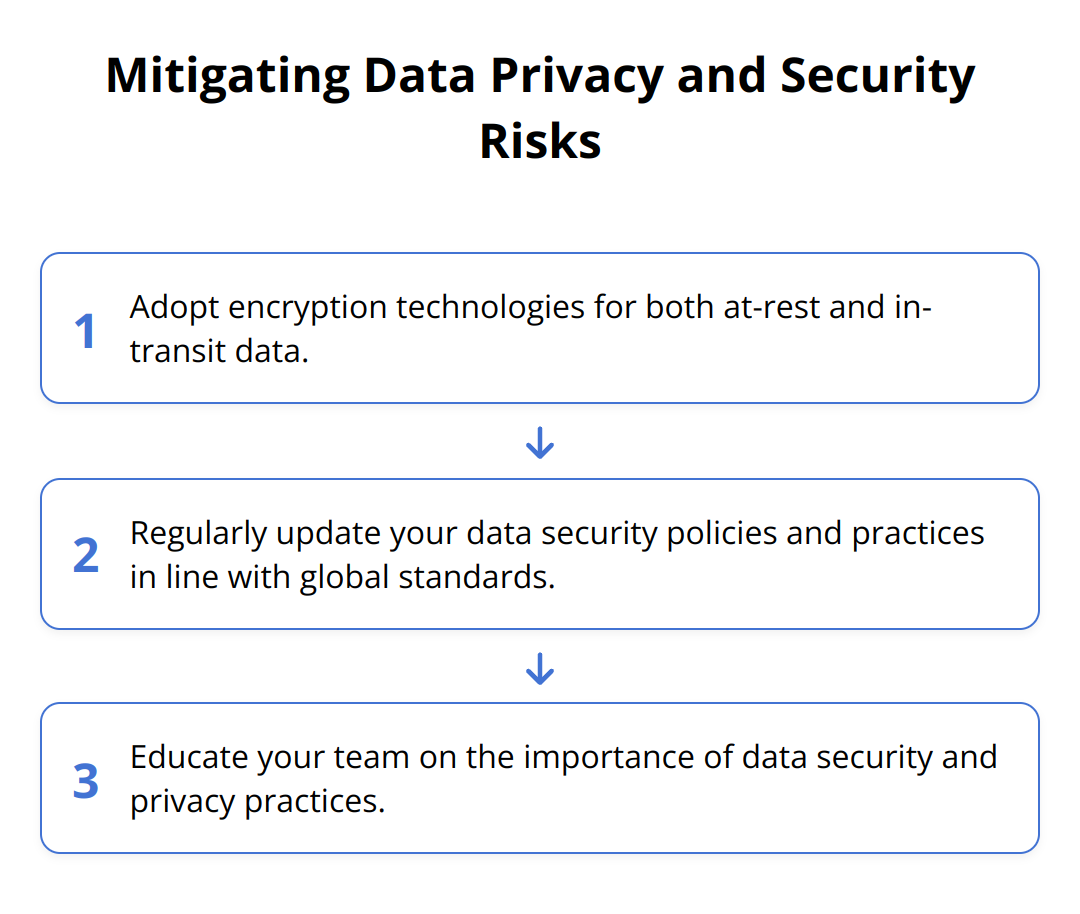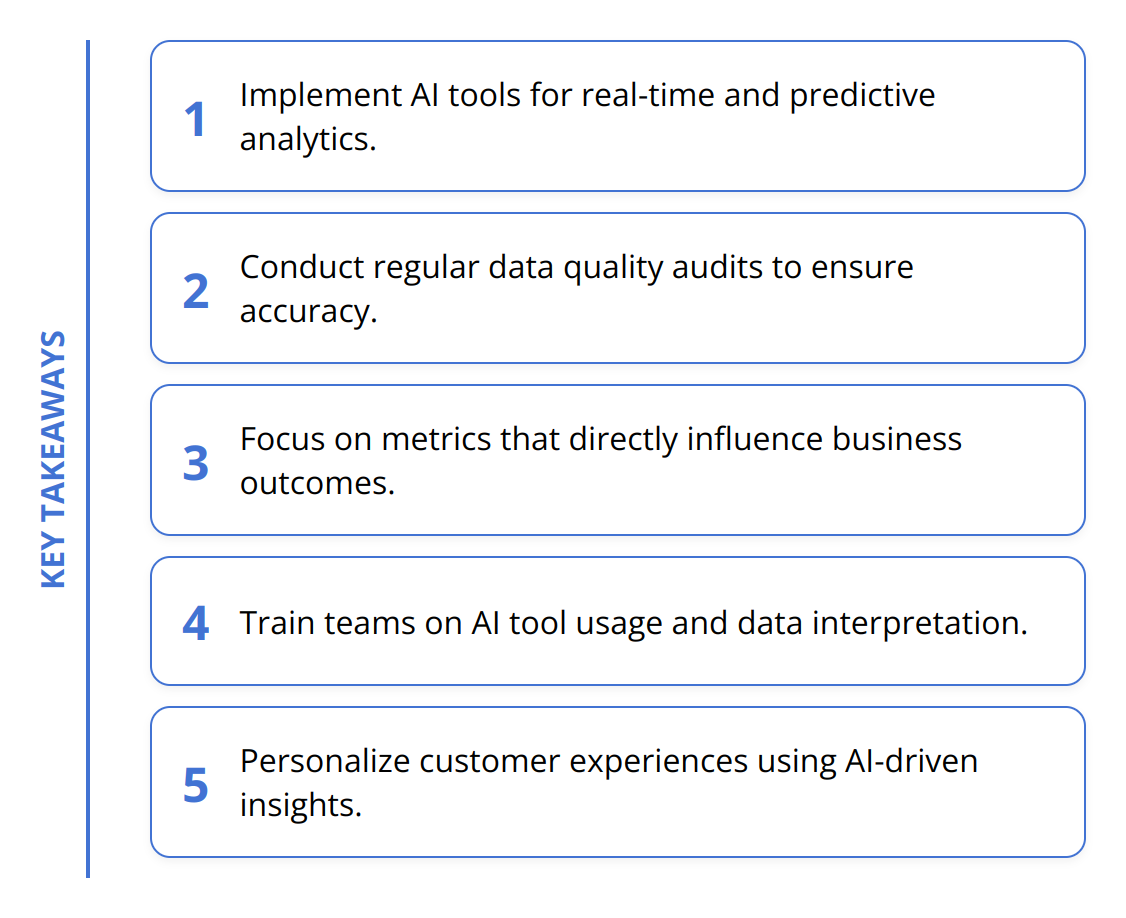Welcome to our guide on navigating the transformative world of AI data analytics in the coming year. We at Emplibot believe understanding and effectively using AI data analytics is essential for businesses to thrive. This article outlines both the strategies for leveraging this technology and ways to address its challenges. Dive into the future of business strategy with us as we explore how to make AI data analytics work for you.
Contents
ToggleHarnessing AI Data Analytics
AI data analytics is evolving rapidly, reshaping how businesses approach strategy and decision-making in 2024. The tools and technologies in AI analytics are becoming more sophisticated, enabling deeper insights and predictions that were previously unachievable. This transformation is not just about leveraging new tools; it’s about understanding the shifting landscape of data analytics and positioning your business to take full advantage.
The Next Generation of AI Analytics Tools
The landscape of AI analytics tools is changing. As we advance, the focus isn’t merely on gathering data but on generating actionable insights. These tools now come equipped with capabilities such as predictive analytics, real-time data analysis, and natural language processing. They are designed to not only process vast amounts of data but also to understand and adapt to the context, making analytics more intuitive and efficient.
Businesses need to identify the right tools that fit their specific needs. For instance, if real-time decision-making is critical, leveraging tools that offer real-time analytics with AI will be a game-changer. The key is to match the capabilities of these advanced tools with your business objectives and the types of data you work with.
Prioritizing Data Quality
The foundation of effective AI data analytics lies in data quality. Without quality data, even the most advanced AI analytics tools can’t perform optimally. Here are some tips to ensure data quality:
-
Regular Audits: Conduct regular data quality checks to identify and rectify inconsistencies or errors.
-
Clear Data Management Policies: Develop and enforce comprehensive data management policies that outline procedures for data collection, storage, and processing.
-
Invest in the Right Tools: Utilize tools designed for data cleaning and preparation to reduce the workload and improve accuracy.
A strong emphasis on data quality can significantly enhance the performance of AI analytics tools, leading to more accurate insights and predictions.

Practical Actions for Businesses
To stay ahead in 2024, companies must:
-
Stay informed about the latest AI analytics tools and their capabilities.
-
Invest in training for teams to efficiently use these tools.
-
Create a data culture that emphasizes the importance of quality data across all departments.
For those looking to deepen their understanding of how data analytics can revolutionize marketing strategies specifically, the post on how data analytics improves marketing provides comprehensive insights.

In conclusion, the ability to strategize with AI data analytics in 2024 hinges on understanding the tools available, prioritizing data quality, and taking practical steps to integrate these technologies into your business operations. Adaptation and proactive management of AI analytics tools will be a determining factor in navigating the challenges and seizing the opportunities of the next year.
Maximizing AI Data Analytics
Integrating AI data analytics into business operations revolutionizes decision-making and strategy formulation. It’s not just about adopting new tools; it’s about fully embracing them to transform your operations, customer interactions, and market understanding.
Fully Embed AI Tools in Daily Workflows
To truly benefit from AI data analytics, businesses must weave these tools into the fabric of their daily processes. This means beyond occasional insights extraction. For example, customer service platforms can use sentiment analysis to tailor interactions or identify issues before they escalate. Inventory management systems equipped with predictive analytics can optimize stock levels, preventing shortages or overstock situations.
Focus on Metrics that Matter
Key to leveraging AI analytics is identifying which data metrics offer the most valuable insights for your business. This isn’t uniform across industries or even companies within the same sector. A retail business might prioritize customer lifetime value and cart abandonment rates, while a SaaS company might focus on user engagement metrics and churn rates. The goal is to identify metrics that directly influence your business outcomes and use AI analytics to monitor these metrics in real-time.

Drive Personalization to New Heights
AI’s power to segment and analyze customer data at an unprecedented scale offers immense opportunities for personalization. Businesses can use data insights to tailor product recommendations, marketing messages, and even pricing strategies to individual customer preferences and behaviors. This level of personalization fosters deeper customer relationships and can significantly boost conversion rates and customer loyalty.
Practical Steps to Consider:
-
Implement AI analytics tools that integrate seamlessly with your existing systems.
-
Train your team not only on how to use these tools but also on interpreting and acting on the insights.
-
Regularly review the metrics you’re tracking to ensure they align with your evolving business goals.
-
Use AI-driven insights to test different approaches in small scales before widespread implementation.
For further guidance on leveraging AI for better marketing outcomes, check out AI in marketing.
Incorporating AI data analytics is not a one-time task but an ongoing journey. As your business evolves, so too should your use of AI tools and the insights you draw from them. By making AI analytics a cornerstone of your operations, you’re positioning your business to compete more effectively in 2024 and beyond.
Overcoming AI Analytics Hurdles
Adopting AI data analytics presents a unique set of challenges, but with the right strategies, these hurdles can be transformed into opportunities for growth and efficiency. One of the biggest stumbling blocks is ensuring data privacy and security, without which customer trust can be easily eroded. Additionally, the accuracy and reliability of data are paramount for insightful analytics. As your business scales, so too must your AI analytics capabilities, creating a need for dynamic solutions.

Navigating Data Privacy and Security
Data privacy and security are not just compliance requirements but are foundational to maintaining customer trust. In 2023, reports highlighted that data breaches could cost companies an average of $4.24 million per incident, underscoring the financial implication of failing to protect data. Here are steps to mitigate these risks:
-
Adopt encryption technologies for both at-rest and in-transit data.
-
Regularly update your data security policies and practices in line with global standards.
-
Educate your team on the importance of data security and privacy practices.

Ensuring Data Reliability
Data’s value lies in its accuracy and reliability. Incorrect data can lead to misguided insights, negatively impacting decision-making. Here’s how to maintain high data quality:
-
Validate data sources before integration to ensure they are reputable and reliable.
-
Implement machine learning models that can identify and correct anomalies in data sets.
-
Regular review and cleansing of data should be a routine part of your data management strategy.
Scaling AI Analytics
As businesses grow, their data analytics needs become more complex. The scalability of AI analytics solutions becomes a critical factor in supporting growth without compromising on performance. Consider these approaches:
-
Opt for cloud-based analytics platforms that offer scalable infrastructure as your data volume and processing needs increase.
-
Use modular AI tools that can be easily integrated or upgraded as your analytics requirements evolve.
-
Design your data architecture with flexibility in mind, allowing for easy incorporation of additional data sources or analytics capabilities.
Quick Tips
-
Audit Data Regularly: Catch inconsistencies that could skew analytics.
-
Continuous Training: Keep your team updated with the latest in AI and security protocols.
-
Personalized Security Measures: Not all data is created equal. Customize your security measures based on data sensitivity.
These strategies offer a pathway for businesses to leverage AI analytics effectively while maintaining robust security measures, ensuring data integrity, and facilitating scalable growth. For insights on implementing real-time analytics, consider reading real-time analytics with AI. Remember, overcoming these hurdles is not just about avoiding pitfalls; it’s about setting your business up for long-term success in a data-driven future.
Wrapping Up
In this journey through the transformative landscape of AI data analytics, we’ve uncovered key strategies, tools, and challenges that businesses will face in 2024 and beyond. The essence of thriving in an increasingly data-driven world hinges on three core principles: leveraging the right AI tools, ensuring data quality, and embracing continuous learning and adaptation.

The adoption of AI data analytics is not merely a trend; it’s a fundamental shift in how businesses operate, make decisions, and interact with customers. The potential for AI to not only enhance efficiency but also to drive innovation and competitive advantage is immense. However, success in this area demands more than just adopting new technologies. It calls for a cultural shift within organizations—a commitment to data literacy, quality, and security that permeates every level of the company.
Continuous learning and adaptation are paramount in this fast-evolving landscape. The AI tools that are cutting-edge today may become obsolete tomorrow. Businesses must stay informed about the latest developments in AI data analytics, adjusting their strategies and tools as needed. This adaptability will ensure that they remain at the forefront of their industry, leveraging data analytics not just for operational efficiency but as a cornerstone of their business model.
We encourage businesses to embrace AI data analytics, not as a challenge to overcome, but as an opportunity to redefine their operations, strategies, and customer relations. The integration of AI into your business processes can be a game-changer, providing insights and efficiency that were previously unimaginable.
Remember, while Emplibot can’t change the trajectory of AI data analytics on its own, we can help you keep pace with these changes by ensuring your online presence remains strong and relevant. By publishing SEO-friendly articles to your WordPress site automatically, we ensure that your business not just keeps up, but excels in the age of AI.
As we look towards 2024 and beyond, the potential of AI data analytics is limitless. But realizing this potential requires more than technology—it requires vision, commitment, and the willingness to innovate. Let’s not view the future with apprehension but as a canvas of endless possibilities that AI data analytics offers. The journey may be complex, but the rewards will be well worth it. By adopting AI data analytics, businesses can unlock new levels of insight, efficiency, and growth. Here’s to navigating the future of business intelligence together, powered by AI.










 Rated Excellent 4.5
Rated Excellent 4.5